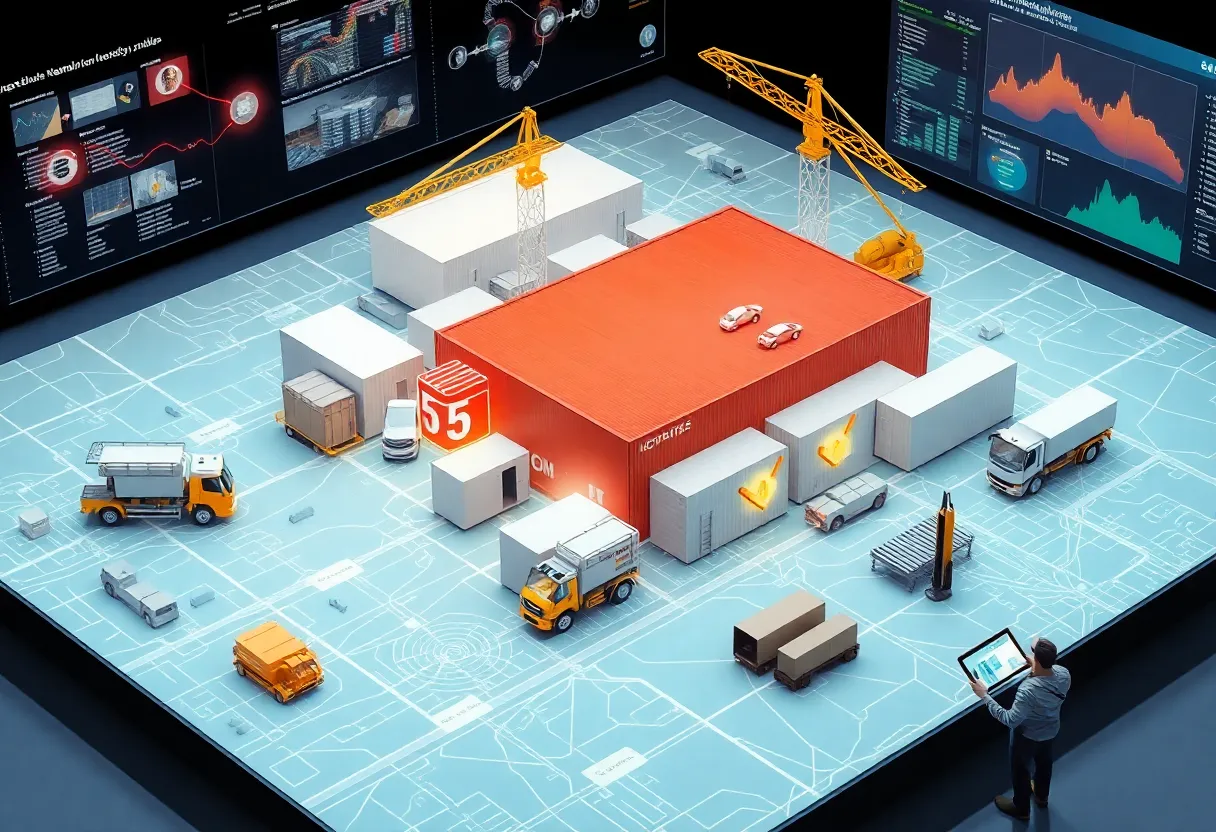Hanyang University ERICA, South Korea, August 19, 2025
News Summary
The researchers at Hanyang University ERICA’s School of Architecture & Architectural Engineering developed a digital twin-enabled facility management system (DT-FMS) for relocatable modular buildings (RMBs). The DT-FMS integrates BIM, IoT and GIS to create a live digital replica that supports real-time monitoring, logistics simulation, lifecycle performance analysis and reuse planning. A case study on a relocatable modular school in South Korea demonstrated improved module distribution, higher reuse potential, better management efficiency and potential reductions in operating costs and energy use. Organized into physical, digital and service layers, the platform enables data-driven decisions across design, transport, setup, operation and circular-economy reuse.
Hanyang University ERICA develops digital-twin facility management system for relocatable modular buildings
The research team from the School of Architecture & Architectural Engineering at Hanyang University ERICA has developed a digital twin-enabled facility management system (DT-FMS) designed specifically for relocatable modular buildings (RMBs). RMBs are presented as a sustainable construction approach where buildings are assembled from prefabricated modules that can be transported and reassembled as needed. The DT-FMS aims to address the unique management and logistics challenges that come with RMBs by integrating multiple digital technologies to enable real-time control, performance assessment and lifecycle planning across projects.
The system combines BIM for robust three-dimensional modelling and comprehensive building information, IoT for real-time sensor data, and GIS for geographic data. When used together, these components support effective logistics of modular units and location-based decision making for RMB projects. The DT-FMS is organized into three management layers—physical, digital and service—to cover both the physical assets and the information that governs them throughout a building’s life cycle.
In the physical layer, real-time tracking and communication are enabled among tangible components such as resources, modular units and people, including stakeholders, engineers and workers. The digital layer provides modelling tools, data integration and analytics to turn sensor feeds into actionable information. The service layer gives users the ability to monitor, control and interact with the digital twin framework to support decision making. These layers together create a cohesive workflow aimed at improving RMB deployment and operation.
Researchers conducted a case study focusing on a relocatable modular school system in South Korea to demonstrate the framework in a practical setting. The study found that applying the digital twin approach improved module distribution and reuse planning, which in turn enhanced overall management efficiency for the school. In some versions of the study, the DT-FMS was described as capable of further reducing operational costs and boosting energy efficiency through optimized logistics and performance monitoring.
Details of the study were published in Volume 176 of Automation in Construction on 1 August 2025, indicating peer-reviewed validation of the framework and its potential applications. The research lead for the project is Associate Professor Yonghan Ahn, with Dennis Nguyen serving as a co-author from the same university. The project positions digital twin technology as a transformative tool in modular construction, with particular emphasis on RMBs where conventional facility management approaches can struggle with rapid assembly, relocation and reuse.
Beyond the RMB project, the university has been involved in broader collaboration activities related to next-generation communications. A separate press release described a memorandum of understanding between VIAVI Solutions and Hanyang University to collaborate on AI-RAN, 5G and 6G research at Hanyang’s Beyond-G Global Innovation Center. The joint effort includes VIAVI contributing wireless lab test solutions and a 6G testbed, while Hanyang University becomes a VIAVI 6G Forward academic partner. The Beyond-G Center has been identified by Korea’s Ministry of Science and ICT and the National Research Foundation of Korea as a hub for the Global Innovation Research Center Support Project, which funds selected national initiatives at more than KRW 5 billion per year for a decade. The Beyond-G Center is pursuing what is described as a world’s first Hyper-space concept to advance next-generation communications and related technologies.
In the VIAVI collaboration, the NITRO® Wireless test and optimization suite will be employed to validate AI-RAN, 5G, 6G and quantum technologies, with capabilities including network emulation, realistic traffic scenarios and cyber threat assessment to simulate changes before deployment in live networks. The partnership is framed as a pathway to training and research opportunities for students and researchers in next-generation communications, with statements from university and industry leaders highlighting the aim of advancing an interoperable telecom infrastructure and associated services toward 6G. The VIAVI portfolio emphasizes its role as a provider of lab-based testing, monitoring and assurance solutions across telecommunications, cloud, enterprise, public safety, and other sectors.
Overall, the articles and releases linked to Hanyang University depict a university actively pursuing independent innovations in construction technology and communications research. The RMB-focused work demonstrates how a digital twin framework can be tailored to the specific needs of modular, relocatable buildings, while the VIAVI partnership illustrates a parallel line of work aimed at building capacity in high-speed, next-generation networks. The combined narrative underscores the university’s role in advancing both physical infrastructure innovations and digital infrastructure research in different but related realms.
Keywords associated with the articles include digital twin, Digital Twins, Hanyang University, modern methods of construction, and Modular Construction.
Related research context and scope
The DT-FMS project is positioned as a targeted application of digital twin concepts to RMBs, a niche that blends modular construction with ongoing facility management needs. By aligning BIM, IoT and GIS in a single framework, researchers aim to support ongoing operations, maintenance planning and logistics optimization across multiple cycles of reuse and relocation, with potential implications for cost containment and energy management in RMB deployments.
Notes on source material and attribution
The primary technical details described above originate from an article by Thomas Johnson dated 18 August 2025 and reflect the university’s published case study and framework description. A separate release dated 10 June 2025 provides context on a university-industry collaboration in next-generation communications, illustrating parallel research directions within the same institution. The two items share a common institution but describe distinct programs and partnerships.
FAQ
- What is the DT-FMS?
- The DT-FMS is a digital twin–enabled facility management system that integrates BIM, IoT and GIS to monitor and optimize relocatable modular buildings throughout their life cycle.
- What are relocatable modular buildings?
- RMBs are buildings assembled from prefabricated modules that can be transported and reassembled, enabling rapid deployment with potential cost and environmental benefits.
- What are the main components of the DT-FMS?
- Three integrated layers—physical, digital and service—that together support real-time tracking, data analytics, and user interaction for decision making.
- What was the case study about?
- The case study evaluated RMB deployment in a modular school system in South Korea to test how the digital twin framework affects module distribution, reuse and overall management efficiency.
- What are the potential benefits mentioned?
- Improved module distribution and reuse planning, reduced operating costs and enhanced energy efficiency through better logistics and performance monitoring.
- Who are the key researchers?
- Associate Professor Yonghan Ahn served as the lead researcher, with co-author Dennis Nguyen contributing from the same university.
- What is the Beyond-G Global Innovation Center collaboration?
- The collaboration with VIAVI Solutions focuses on AI-RAN, 5G and 6G research, including a 6G testbed, at a center supported by national research funding and government programs.
- When and where was the DT-FMS study published?
- The DT-FMS study and its findings appeared in Volume 176 of Automation in Construction on 1 August 2025.
- What broader implications does the work imply?
- Beyond RMBs, the research highlights how digital twins can contribute to lifecycle management, circular economy goals, and smarter logistics across modular construction projects.
| Feature | Description |
|---|---|
| DT-FMS core concept | A digital twin framework that fuses BIM, IoT and GIS to manage RMBs across their life cycle. |
| Relocatable modular buildings | Modular components designed for fast transport and reassembly with potential cost and environmental benefits. |
| Three-layer structure | Physical layer for real-time tracking, digital layer for modelling and analytics, service layer for user interaction and decision support. |
| Case study focus | Testing DT-FMS in a relocatable modular school system in South Korea to assess logistics and reuse planning benefits. |
| Potential benefits | Improved module distribution, enhanced reuse, reduced operating costs and better energy efficiency through data-driven decisions. |
| Related collaborations | Partnerships exploring next-generation communications at the Beyond-G Global Innovation Center, including AI-RAN, 5G and 6G research. |
Deeper Dive: News & Info About This Topic
Additional Resources
- IoT World Today: Researchers develop digital twin framework to streamline construction
- Wikipedia: Digital twin
- New Civil Engineer: Researchers develop digital twin technology for modular building management
- Google Search: digital twin relocatable modular buildings
- MSN: Digital twin system transforms management of relocatable modular buildings
- Google Scholar: digital twin modular buildings
- PR Newswire: Viavi and Hanyang University sign memorandum of understanding to advance 6G research
- Encyclopedia Britannica: Hanyang University
- Telecoms.com: Viavi and South Korean university team up to work on AI RAN, 5G and 6G research
- Google News: Viavi Hanyang 6G





